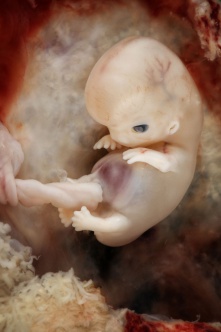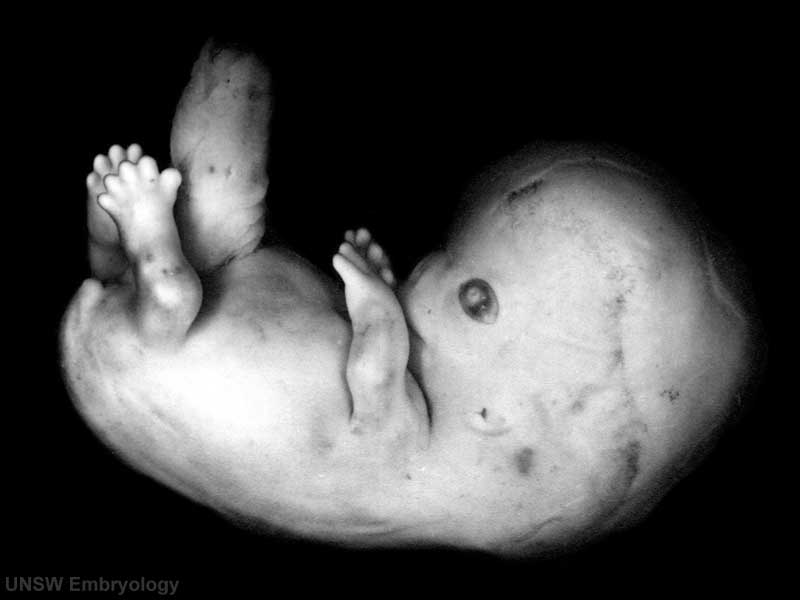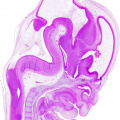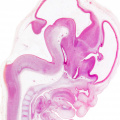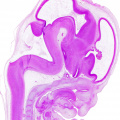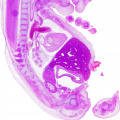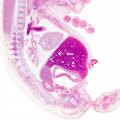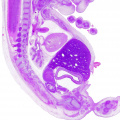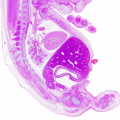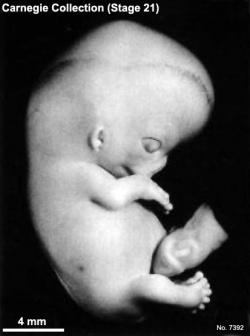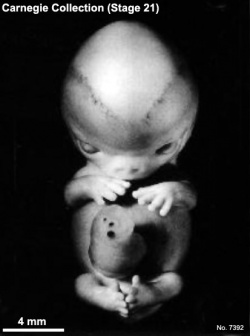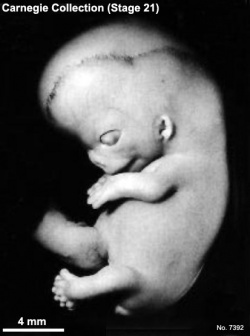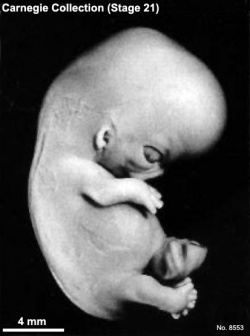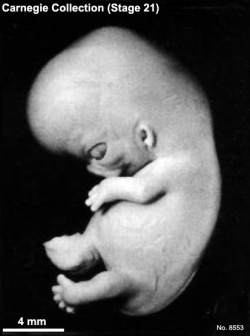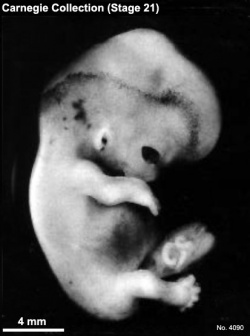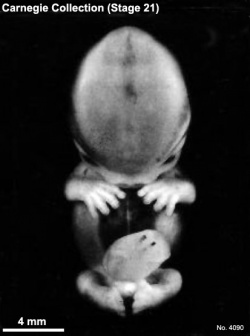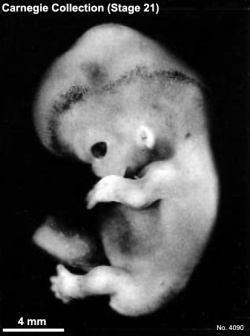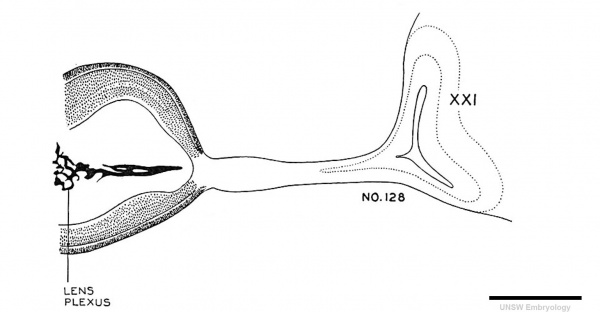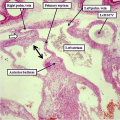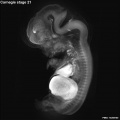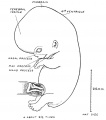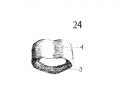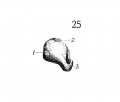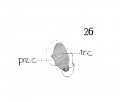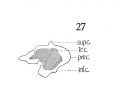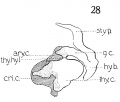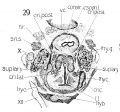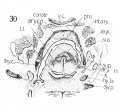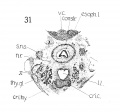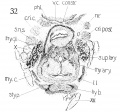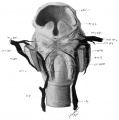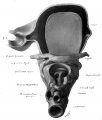Carnegie stage 21
| Embryology - 27 Apr 2024 |
|---|
| Google Translate - select your language from the list shown below (this will open a new external page) |
|
العربية | català | 中文 | 中國傳統的 | français | Deutsche | עִברִית | हिंदी | bahasa Indonesia | italiano | 日本語 | 한국어 | မြန်မာ | Pilipino | Polskie | português | ਪੰਜਾਬੀ ਦੇ | Română | русский | Español | Swahili | Svensk | ไทย | Türkçe | اردو | ייִדיש | Tiếng Việt These external translations are automated and may not be accurate. (More? About Translations) |
Introduction
Facts
Week 8, 53 - 54 days, 22 - 24 mm
Gestational age GA week 10
Summary
- Ectoderm: sensory placodes, nasal pits moved ventrally, fourth ventricle of brain
- Mesoderm: heart prominence, ossification continues
- Head: nose, eye, external acoustic meatus
- Body: straightening of trunk, heart, liver, umbilical cord
- Limb: upper limbs longer and bent at elbow, foot plate with digital rays begin to separate, wrist, hand plate with webbed digits
See also Carnegie stage 21 Events
Features
- scalp vascular plexus, eylid, eye, nose, auricle of external ear, arm, elbow, wrist, knee, notch between digital rays, umbilical cord
- Identify: straightening of trunk, pigmented eye, eyelid, nose, external acoustic meatus, scalp vascular plexus, webbed digits, liver prominance, thigh, ankle, foot plate, umbilical cord
| Week: | 1 | 2 | 3 | 4 | 5 | 6 | 7 | 8 |
| Carnegie stage: | 1 2 3 4 | 5 6 | 7 8 9 | 10 11 12 13 | 14 15 | 16 17 | 18 19 | 20 21 22 23 |
- Carnegie Stages: 1 | 2 | 3 | 4 | 5 | 6 | 7 | 8 | 9 | 10 | 11 | 12 | 13 | 14 | 15 | 16 | 17 | 18 | 19 | 20 | 21 | 22 | 23 | About Stages | Timeline
Bright Field
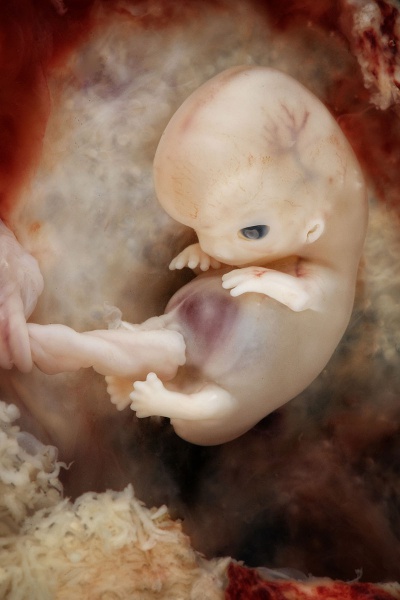
|
Virtual Embryo Slides
|
Kyoto Collection
View: This is a dorsolateral view of embryo. Amniotic membrane removed.
| Central Nervous System | |
|---|---|
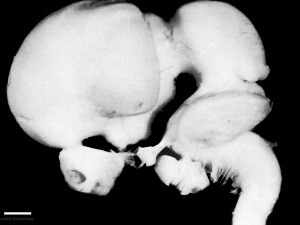
|

|
| left lateral view | medial view |
| scale bar = 1mm |

|
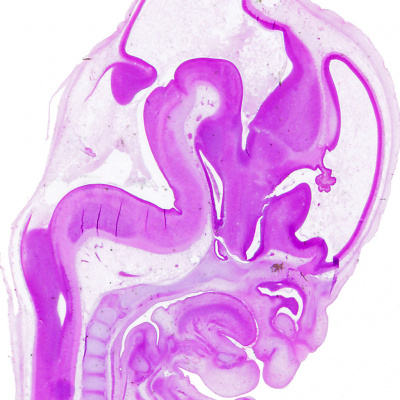
|
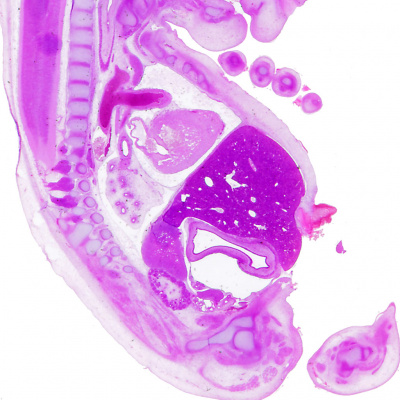
|
- Kyoto embryo 940 Histology
Image source: The Kyoto Collection images are reproduced with the permission of Prof. Kohei Shiota and Prof. Shigehito Yamada, Anatomy and Developmental Biology, Kyoto University Graduate School of Medicine, Kyoto, Japan for educational purposes only and cannot be reproduced electronically or in writing without permission.
Carnegie Collection
- Carnegie stage 21: 7592 Right | 7592 Anterior | 7592 Left | 8553 Right | 8553 Anterior | 8553 Left | 4090 Right | 4090 Anterior | 4090 Left
| Carnegie Collection - Stage 21 | |||||||||||
|---|---|---|---|---|---|---|---|---|---|---|---|
| Serial No. | Size (mm) | Grade | Fixative | Embedding Medium | Plane | Thinness (µm) | Stain | Point Score | Sex | Year | Notes |
| 22 | E, 20 Ch, 35x30x30 | Good | Alc. | P | Transverse | 50 | Al. coch. | 34.5 | Female | 1895 | |
| 57 | E, 23 Ch., ca. 30 | Poor | Alc. | P | Sagittal | 50 | Al. coch. | 36 | Male | 1896 | |
| 128 | E, 20 Ch., 50x43 | Good | Formalin | P | Coronal | 50 | Al. coch. | 33 | Female | 1898 | |
| 229 | E, 19 | Poor | Alc. | P | Sagittal | 50 | Al. coch. | 33 | Female | 1903 | |
| 349 | E, 24 | Good | Zenker | C | Coronal | 250 | Unstained | 36 | ? | 1905 | Double vascular injection |
| 455 | E, 24 Ch., 42x34x20 | Good | Alc. | P | Transverse | 30 | (Stain - Haematoxylin Eosin) | 36.5 | Male | 1910 | |
| 632 | E, 24 Ch., 60x50x30 | Good | Bichlor. acetic | P | Sagittal | 40, 100, 250 | Al. coch. | 33 | Female | 1913 | Injected |
| 903C | E, 23.5 | Good | Formalin | P | Transverse | 40 | Al. coch. | 38.5 | Female | 1914 | |
| 1008 | E, 26,4 | Good | Formalin | P | Sagittal | 40 | Al. coch. | 39 | ?? | 1914 | |
| 1358F | E, 23 | Good | Formalin | P | Sagittal | 40 | Al. coch. | 37.5 | Female | 1916 | |
| 2937 | E,, 24.2 | Good | Bouin | P | Transverse | 50 | (Stain - Haematoxylin Eosin) aur., or. G. | 39 | Female | 1920 | |
| 3167 | E., 24.5 Ch., 60x50x40 | Poor | Bichlor, acetic, formol | P | Transverse | 20 | Al. coch. | 32 | Male | 1920 | |
| 4090 | E, 22.2 Ch.. 66x46x30 | Good | Formalin | P | Transverse | 40 | Al. coch. | 30 | Female | 1922 | |
| 4160 | E,25 | Poor | Formalin | P | Sagittal | 25 | (Stain - Haematoxylin Eosin) | 39 | Male | 1923 | Tubal |
| 4960 | E.22 Ch,, 47x42x28 | Good | Formalin | P | Transverse | 15 | Al. coch., Mallory | 31.5 | Female | 1925 | |
| 5??6 | E. 215 | Good | Formalin | P | Sagittal | 20 | (Stain - Haematoxylin Eosin) | 34 | Female | 1927 | |
| 6531 | E,22 | Poor | Glacial acetic, | C-P | Transverse | 10 | (Stain - Haematoxylin Eosin) | 31.5 | Female | 1931 | Leitz Collection |
| 7254 | E,225 | Exc | Bouin | C-P | Transverse | 20 | (Stain - Haematoxylin Eosin) | 33.5 | Male | 1936 | |
| 7592 | E,22-> | Exc. | Bouin | C-P | Transverse | 20 | (Stain - Haematoxylin Eosin) | 36 | Female | 1937 | |
| 7864 | E., 24 | Exc, | Formalin | C-P | Frontal | 20 | (Stain - Haematoxylin Eosin) | 32.5 | Male | 1941 | |
| 8553 | E., 22 | Exc | Bouin | C-P | Transverse | 12 | (Stain - Haematoxylin Eosin) | 38 | Female | 1947 | |
| 9614 | E,,22 5 | Exc | Bouin | P | Coronal | 10 &15 | Azan | ? | ? | 1958 | Rubella. Hysterectomy |
Abbreviations
| |||||||||||
| iBook - Carnegie Embryos | |
|---|---|
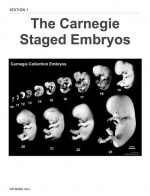
|
|
Hinrichsen Collection
| frontal section | respiratory excerpt |
|---|---|
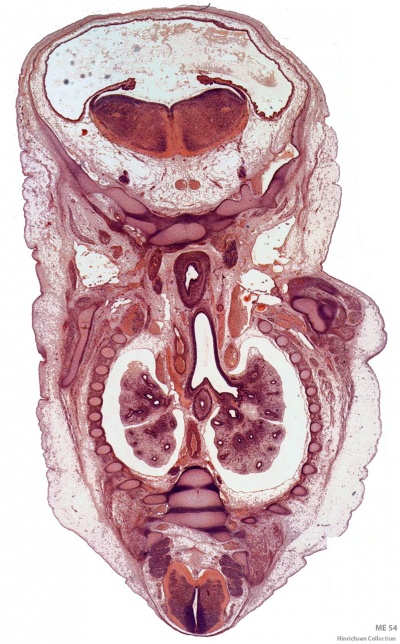
|
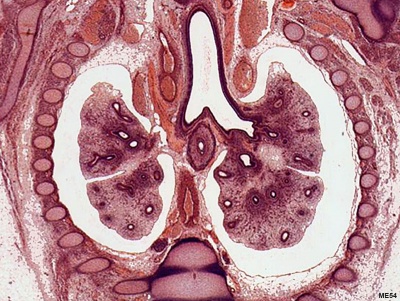
|
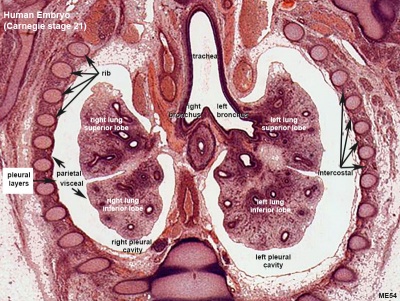
|
- Links: frontal section | respiratory excerpt | labeled respiratory excerpt | Carnegie stage 21 | Week 8 | Hinrichsen Collection
Image source: The Hinrichsen Collection images are reproduced with the permission of Prof. Beate Brand-Saberi, Head, Department of Anatomy and Molecular Embryology, Ruhr-Universität Bochum. Images are for educational purposes only and cannot be reproduced electronically or in writing without permission.
Digital Embryology Consortium - Hinrichsen Collection
Madrid Collection
| Madrid Collection Embryos | ||||||
|---|---|---|---|---|---|---|
| Carnegie Stage |
Embryo | Days | CRL (mm) | Section thickness |
Staining | Section plane |
| 21 | GV 7 | 51 | 22 | 10 | (Stain - Haematoxylin Eosin) | sagittal |
Events
- hearing - tip of the cochlea is recurved.
- vision - (stage 19 -22) the eyelid folds develop into the eyelids and cover more of the eye as the palpebral fissure takes shape. The upper and the lower eyelids meet at the outer canthus in Stage 19.[2]
- smell - the structure of the olfactory bulb is evident. [3] primitive olfactory bulb
- Musculoskeletal
- Mandible bone-formation has taken place and formed a plate on the lateral side of Meckel's cartilage; this plate is in the substance of, and is surrounded by, that mesodermal condensation which outlines the mandible and precedes the formation of bone. The plate of bone is confined to the region of what approximately corresponds to the future body of the mandible, but the mesodermal condensation can be traced further backwards, always, of course, on the lateral side of Meckel's cartilage and the associated branches of the mandibular nerve. The condensation admittedly becomes gradually much less sharply defined but is still distinguishable from the surrounding tissue. Finally, some distance beyond the limit of bone-formation, the lateral pterygoid muscle can be seen running into and out- lining the terminal part of the mesodermal condensation. This is the first indication of the condylar process in my series (P1. 1, fig. 1). Meckel's cartilage with the inferior dental and lingual nerves on its upper surface lies medial to this rudimentary condylar area and inferior to the lateral pterygoid muscle.[4]
- Joint - knee posterior cruciate ligament present.[5]
- Cardiovascular
- Cerebral artery the formation of the anterior communicating artery.[6]
- Endocrine System Development[7]
- Hypophysis - the pharyngeal stalk becomes fragmented (Jirfisek 1980).
- Adrenal Cortex - the cellular "capsule" becomes covered by a layer of fibrous tissue.[8]
- meninges (spinal cord) - cavity formation in the meninx primitiva has progressed, and the rudimentary ventral dura is more distinct. Ventral to the medial edge of the ganglia, this dense dural rudiment is separated from the lateral extremities of the centra and intervertebral disks. Within this space a large longitudinal venous channel is developing. The dura can be identified around the spinal ganglia, which are now shifting into the intervertebral foramina, but becomes less distinct as it passes dorsad. The ventral dura can be followed throughout the cervical, thoracic, and lumbar segments, but in the sacral segments it can be identified only on the dorsal surfaces of the intervertebral disks.[9]
- genital[10]
- submandibular gland - Simple, stubby primary branching of duct.[1]
- palate - levator veli palatini muscle starts to develop beneath the aperture of the auditory tube to the pharynx. Same authors suggest levator veli palatini may be derived from the second branchial arch.[12]
- limb - neural stage 21 the upper limb nerves are in an orientation and arrangement similar to those in the adult.[13]
References
- ↑ 1.0 1.1 Streeter GL. Developmental Horizons In Human Embryos Description Or Age Groups XIX, XX, XXI, XXII, And XXIII, Being The Fifth Issue Of A Survey Of The Carnegie Collection. (1957) Carnegie Instn. Wash. Publ. 611, Contrib. Embryol., 36: 167-196.
- ↑ Pearson AA. The development of the eyelids. Part I. External features. (1980) J. Anat.: 130(1): 33-42. PMID 7364662 PDF
- ↑ Bossy J. Development of olfactory and related structures in staged human embryos. (1980) Anat. Embryol., 161(2);225-36 PMID 7469043
- ↑ SYMONS NB. (1952). The development of the human mandibular joint. J. Anat. , 86, 326-32. PMID: 12980883
- ↑ Mérida-Velasco JA, Sánchez-Montesinos I, Espín-Ferra J, Mérida-Velasco JR, Rodríguez-Vázquez JF & Jiménez-Collado J. (1997). Development of the human knee joint ligaments. Anat. Rec. , 248, 259-68. PMID: 9185992
- ↑ Menshawi K, Mohr JP & Gutierrez J. (2015). A Functional Perspective on the Embryology and Anatomy of the Cerebral Blood Supply. J Stroke , 17, 144-58. PMID: 26060802 DOI.
- ↑ O'Rahilly R. The timing and sequence of events in the development of the human endocrine system during the embryonic period proper. (1983) Anat. Embryol., 166: 439-451. PMID 6869855
- ↑ Crowder RE. The development of the adrenal gland in man, with special reference to origin and ultimate location of cell types and evidence in favor of the "cell migration" theory. (1957) Contrib. Embryol., Carnegie Inst. Wash. 36, 193-210.
- ↑ Sensenig EC. The early development of the meninges of the spinal cord in human embryos. (1951) Contrib. Embryol., Carnegie Inst. Wash. Publ. 611.
- ↑ O'Rahilly R. (1983). The timing and sequence of events in the development of the human reproductive system during the embryonic period proper. Anat. Embryol. , 166, 247-61. PMID: 6846859
- ↑ Wilson KM. Origin and development of the rete ovarii and the rete testis in the human embryo. (1926) Carnegie Instn. Wash. Publ. 362, Contrib. Embryol., Carnegie Inst. Wash., 17:69-88.
- ↑ Kishimoto H, Yamada S, Kanahashi T, Yoneyama A, Imai H, Matsuda T, Takeda T, Kawai K & Suzuki S. (2016). Three-dimensional imaging of palatal muscles in the human embryo and fetus: Development of levator veli palatini and clinical importance of the lesser palatine nerve. Dev. Dyn. , 245, 123-31. PMID: 26509917 DOI.
- ↑ Shinohara H. Naora H. Hashimoto R. Hatta T. and Tanaka O. Development of the innervation pattern in the upper limb of staged human embryos. (1990) Acta Anat (Basel) 138: 265-269. PMID 2389673
Additional Images
Historic Images
| Historic Disclaimer - information about historic embryology pages |
|---|
| Pages where the terms "Historic" (textbooks, papers, people, recommendations) appear on this site, and sections within pages where this disclaimer appears, indicate that the content and scientific understanding are specific to the time of publication. This means that while some scientific descriptions are still accurate, the terminology and interpretation of the developmental mechanisms reflect the understanding at the time of original publication and those of the preceding periods, these terms, interpretations and recommendations may not reflect our current scientific understanding. (More? Embryology History | Historic Embryology Papers) |
- Carnegie Stages: 1 | 2 | 3 | 4 | 5 | 6 | 7 | 8 | 9 | 10 | 11 | 12 | 13 | 14 | 15 | 16 | 17 | 18 | 19 | 20 | 21 | 22 | 23 | About Stages | Timeline
Cite this page: Hill, M.A. (2024, April 27) Embryology Carnegie stage 21. Retrieved from https://embryology.med.unsw.edu.au/embryology/index.php/Carnegie_stage_21
- © Dr Mark Hill 2024, UNSW Embryology ISBN: 978 0 7334 2609 4 - UNSW CRICOS Provider Code No. 00098G

